Just to let you know, this is going to be a long post, mostly because of the number of vertical-format images, and there’s a good chance that you’re going to wear out the scroll wheel on your mouse (because you wouldn’t be so gauche as to surf this site on your smutphone or tablet of course.) This probably isn’t the best time to tell you that I’ve picked up a new sponsor for the blog: Logitech, maker of quality mice and keyboards! For the best choices of a long-lasting computer mouse, think Logitech!
Moving on. The Girlfriend and I took a walk around the neighborhood pond near sunset the other night, and on our return she glanced down and said, “Ooh, look at that!” What she was pointing to was a cicada, a fourth-instar nymph, which basically means one that has recently emerged from underground and is about to molt into its adult, reproducing form. This is what makes those largish brown husks that are so easy to find on tree trunks in the summer.
Now, it was dusk, under a full tree canopy, and the dirt-covered nymph was against a patch of dirt, so full credit to her for spotting it. Meanwhile, I have never gotten photos of any species as it began its molt, though I’ve caught a few partway through the process. So, I picked it up and brought it back home to begin a long photo session.
First off, the setup. I started by placing the cicada on an uprooted sapling we have in the yard, but it showed an inclination to heading into a thicket of small branches which might have hampered my views, so I removed it from there and placed it on a cedar stump, then quickly went to get all the equipment necessary. This included not just the camera and macro flash, but an extension cord to feed the AC power supply for the flash (what a marvelous option – more manufacturers need to be doing this) and the LED desk lamp, mentioned in the previous post, for a focusing light. All of this, including the stump, was set on a table on the back deck and I pulled up a chair because I knew from experience this was going to be a long session. The cicada wandered around on the stump for a bit before finally choosing a spot, which was a bit too close to another little spike of wood, so I carefully pried that away so it wouldn’t interfere with either the molting itself or my view of it.

I toyed with the idea of setting up a second camera to do a sequence of time lapse images, but only had one AC-powered flash unit and knew it would require a lot of images, plus the fact that a tripod and light stand might be getting in the way, so I let the opportunity go this time around in favor of getting the details shots that I really wanted. The cicada was now rocking gently back and forth as if walking in place, and I was pretty certain it was either freeing itself from its exoskeleton internally or trying to produce the split on the back that it would emerge from, and I stayed put and kept a close eye on it. It was now full dark, so my focus and observation lighting was entirely the desk lamp, though the flash unit illuminated the images much better. I will refer you to the time markings on the images so you can see just how the activity progresses.

Notable here is that you can see the coloration and faintly make out the false pupil of the compound eyes under that exoskeleton, which I believe have only just developed – the underground nymphs do not appear to have them, or indeed much of any eye development because, why? And while nothing visible was happening, I was pretty sure I was seeing a faint line down the center of the thorax that I hadn’t seen before.
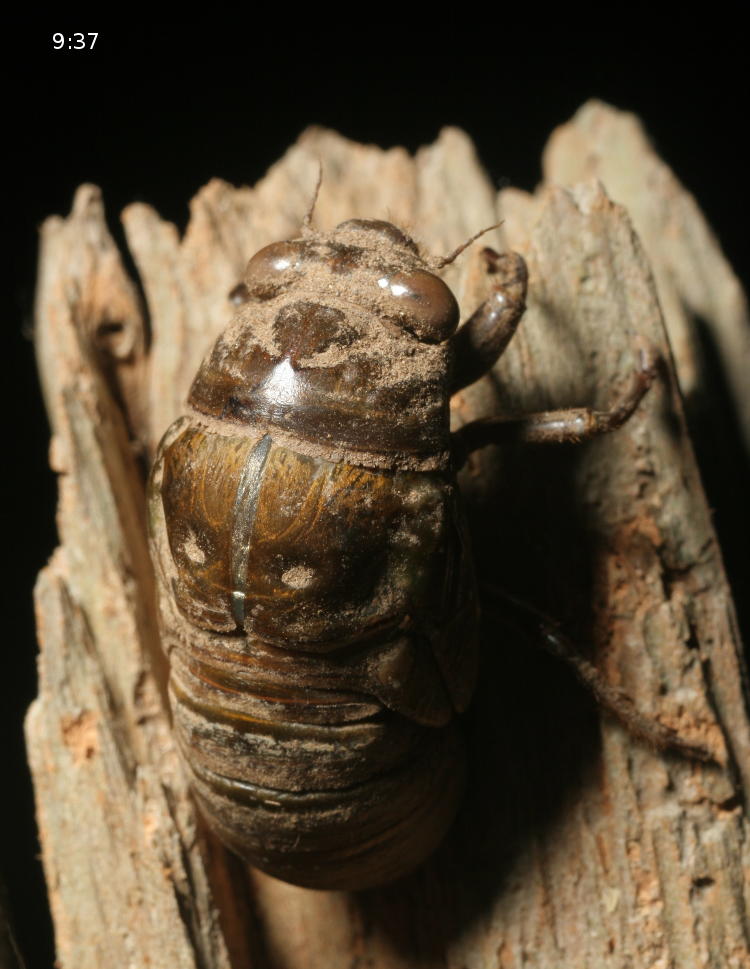
Ah yes, there it is! I will point out here that the cicada measures about 30mm in length at this stage (the discarded exoskeleton, a few days later, was measured at 31mm,) so the peek of different coloration was subtle, but unmistakable if you’re looking as hard as I was for it – again, the flash brought things out a lot better than I was seeing by the desk lamp.
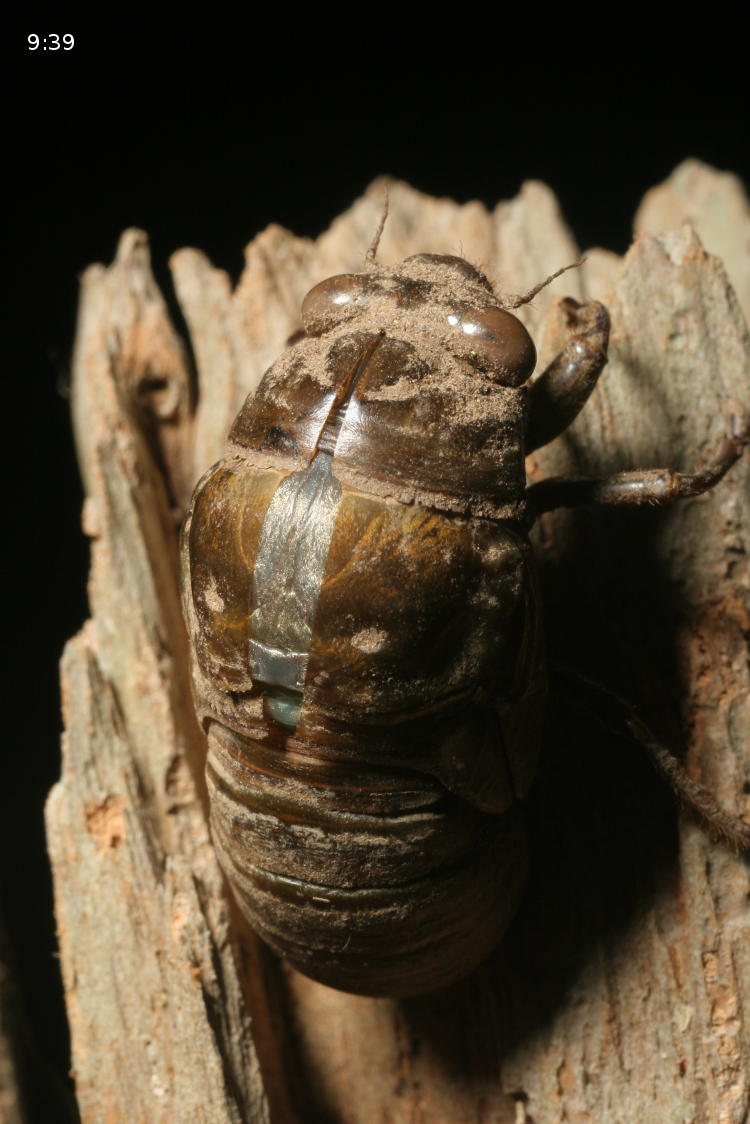
The cicada had stopped rocking by this point and, as the time stamps might indicate, the progress was only visible by comparing what it had looked like when you’d turned away a moment ago. This was not a situation where the frame-per-second rate of the camera was going to be a hindrance. Which was nice, actually, because I could pick my framing and even adjust the flash for better illumination.
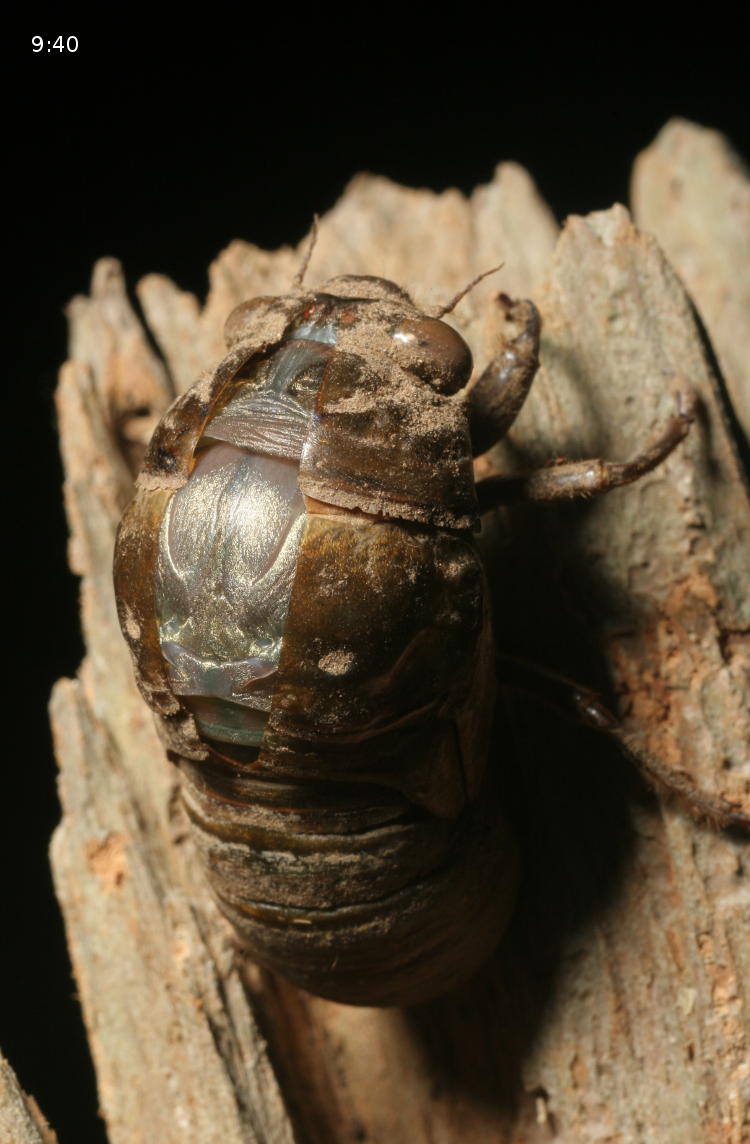
Here the split has progressed to the head, and we get our first peek of the secondary eyes, three simple eyes that sit on the ‘forehead’ and are presumed to aid in orientation while flying. They’re red here, but will turn darker later on.

A view from a different angle, where we can see the geometric separation of the exoskeleton. The pattern is always the same, a natural perforation much more dependable than any pasta box. Not only can you see the primary false pupil now, but a hint of the surrounding secondary false pupils in the main eyes – you’ll get a better look a little further on.

A nice view of the bulging thorax and the flexing of the body segments; the legs are probably being drawn free at this point. You might expect at least some wiggling, but you’d be wrong. Everything seemed perfectly still.

Moving right along now. I was waiting for the eyes to pop free, and you can see that the eyes on the exoskeleton now seem empty, even though I couldn’t make this out at the time. I also couldn’t make out a detail that’s quite clear here: the wings have partially withdrawn as well, showing their crumpled nature right in the center of the frame. I know I kind of expected them to develop folded or curled, maybe like flower petals do, but they instead seem to form in the shape of a sock that’s slipped off and is crumpled inside the toe of a boot.
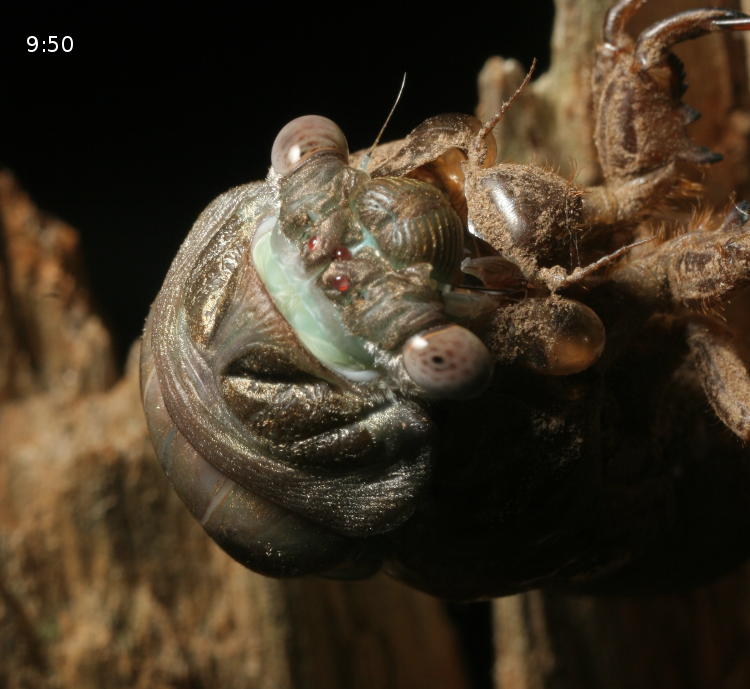
Abruptly the eyes were visible, and even though I was watching for this aspect they seemed a lot further out than I expected. It’s possible that the exoskeleton snapped back a little when those bulbs popped free, but again, I saw no noticeable movement. While we’re here, I’ll point out the the pale blue regions will be flexible ‘skin’ while the darker regions will harden into the protective chitin that we’re all familiar with on virtually all arthropods.

I told you that we’d get a better look at the primary and secondary false pupils, and for giggles see how they appear in the left eye away from us. Cicada eyes are dense and complicated, and we’ll get a better look at that aspect too. Maybe you’ll believe me this time. Until then, also check out the antennae.
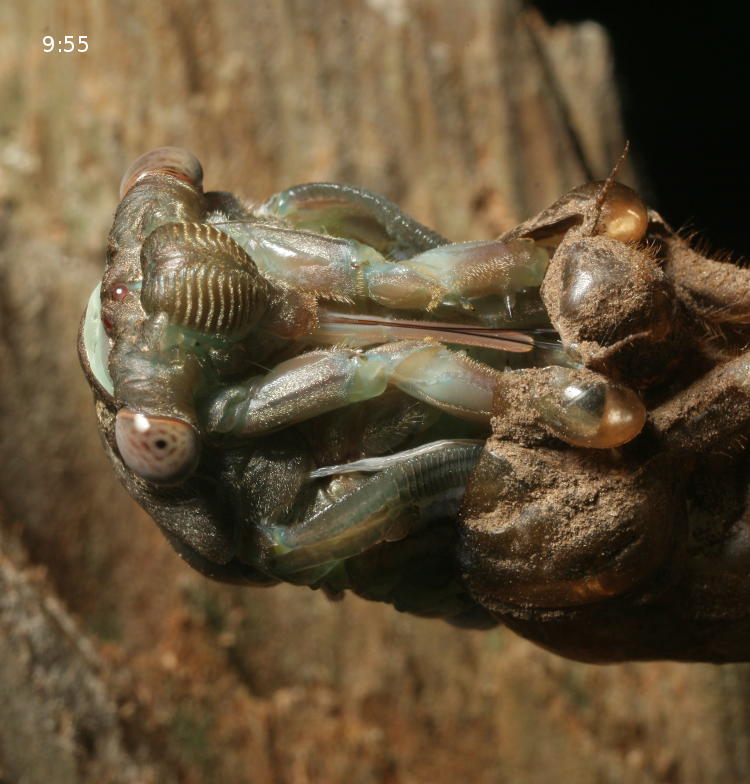
Now we can see the wings starting to spread out the slightest bit, and the proboscis is visible. The first pair of legs is completely free but the cicada hasn’t started to flex them yet.

The money shot here is that white thread stretching to the side of the emerging cicada. That is, essentially, the lining of its ‘lungs,’ or more specifically the tracheoles that feed oxygen into the body. See here for details about this aspect of molting, and here for more detailed pics of the organs themselves than you ever wanted to see. You can see in this image that there also seems to be a lining to the proboscis that’s pulling free too. Now you have something to talk about at work tomorrow.
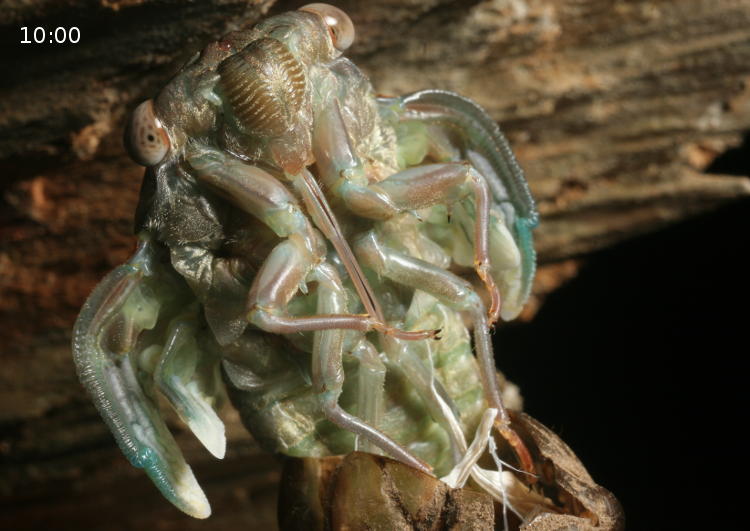
The tracheoles have all pulled free now, the first two pairs of legs were out and starting to flex a little, providing the first visible motion from the cicada, and the wings were unfurling almost visibly – the progress was easily noticeable. This is an odd angle for detail, because the cicada had anchored itself vertically and was now leaning back from its exoskeleton almost horizontally, an extremely slow trust fall. I was very glad I’d placed the stump on a table, because I could choose my shooting angle without any discomfort at all, a rarity for arthropod macro work.
It is now about 80 minutes since The Girlfriend had found the cicada on the ground, and an hour since I’d set up the ‘studio.’ I remember sitting back in the chair at some point and looking up at the small patch of clear sky that could be seen from our backyard, and the moon peeking through the trees.

A more natural angle, the camera being pretty much dead-level now. The legs are all free, though the last haven’t been flexed to bring them out of the opening in the exoskeleton. By now, the cicada had been making minute vibrations, as if it was gently being tapped or a T-Rex was approaching, and it is anchored solely by its lower abdomen. In fact…

… I tried to get a better look down there to see this, because I’m not sure at all how insects remain anchored this way for long periods, but all of them seem to do it. What’s going on down there? This was the beginning of several minutes where nothing at all seemed to be happening, save for the occasional feeble flexing of a leg and the continued unfurling of the wings.

Note the time stamp. The cicada had been so far back that its left eye was actually resting against the wood behind it, but now it had started to flex forward in an abdominal crunch even more painfully slow than my own. Which was good, because those wings were close to contacting the wood on that side and I was concerned about them opening properly. The legs were twitching a little more now.

Just a look at the wings in detail. I was expecting them to twitch or pulse or something but they simply stretched out infinitesimally slowly. Arthropods don’t really have a circulatory system as aggressive as ours anyway, so pulsing isn’t appropriate.

Leaning forward now – those legs are going to grasp its own exoskeleton aaannyyy second now…

That’s right, get a good grip before you pull your ass free or you’ll fall down, and your chitin isn’t hardened yet.

We have now reached the gripping action sequence, the fastest motion of the entire process – again, time stamps. The legs have a good grip, there’s some flexing…

… and the abdomen pops free with a visible tiny jerk. I don’t mind telling you I was sweating at this point – but then again I’d been sweating the entire time, because it was still pretty damn warm that evening. At some point, I glanced up again and noticed that there were now thin scattered clouds across the sky, surprising me slightly.

Now properly supporting itself on its legs, the cicada shifted position slightly and the wings continued to extend. I knew that not a lot would happen for a while, as the wings filled out and the chitin dried and hardened.

A profile shot to show the secondary wings still curled a bit but moving along nicely.

Welcome to adulthood and sexual maturity – and, by the way, the introduction of predators. Admittedly, there were probably some critters like moles that might prey on the underground nymph stage, and perhaps some things that could scarf up the newborns before they made their way down the tree trunks to burrow into the ground, but this stage by far is the most dangerous. However, there’s sex.
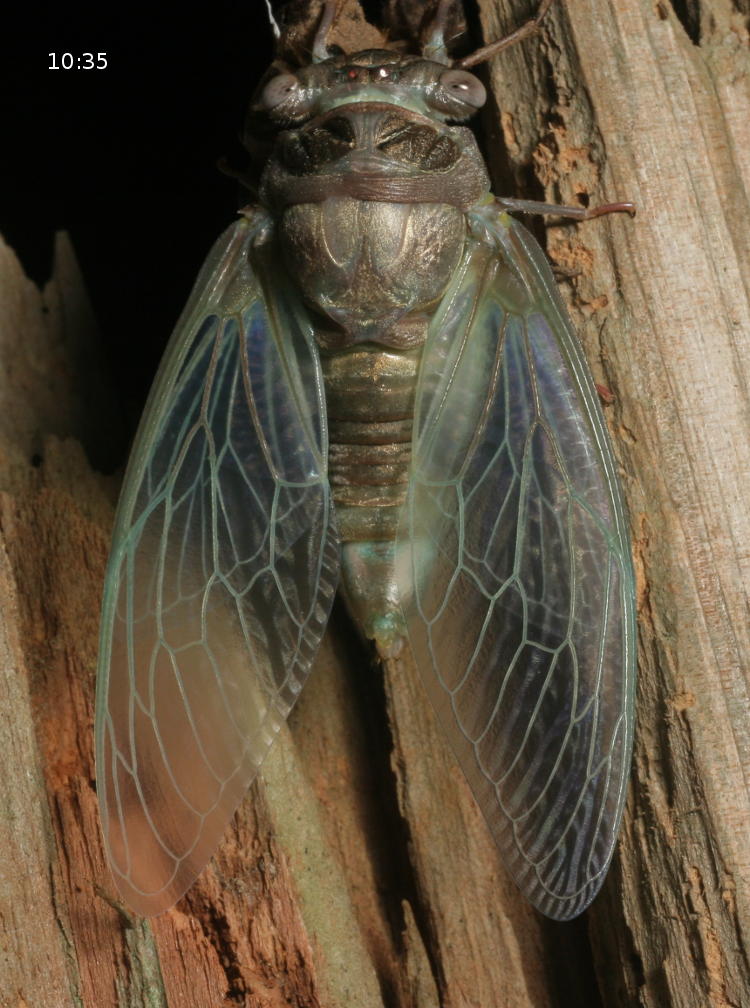
I have to say that the appearance of the wings by the light of the desk lamp was a bit different than the flash produced, and I tried several lighting angles to try and illustrate it, but I doubt I did a good job. Nonetheless, what you can see here are the faint indications of all the fold lines, like pretty much all of my own clothes because ironing is a pain in the ass. The first hints of the iridescence that the wings will display in the right light is now showing, and after a while the wings will tilt a bit and clasp close to the abdomen. I waited around for another fifteen minutes, but there was no visible change and I knew the most that I’d see would be a color shift as the chitin hardened, so I packed up the equipment, satisfied that I’d gotten what I was after. It had been two hours since finding the nymph.
Inside the house later on I passed the back door and heard the unmistakable sounds of a downpour, and went out after it had largely passed to do a followup image just for the story. The cicada was now looking mostly like a flying adult, and had shifted even more – you can just make out the abandoned exoskeleton at upper left.

Then, after unloading the memory card for the second time, I noticed some curious details and wanted to do them justice, so I switched lenses to the reversed 28-105 super-macro and went back out. Remember what I said about eye detail?

A single raindrop was acting as a lens and magnified the surface of the compound eye much greater than even my super-macro was capable of – you can see why I had to do this one right. Also note the myriad patterns of the compound eye, fulfilling some purpose to the cicada but I’ll be dipped if I can tell you what. The entire eye surface is perhaps 3mm across, so you can do the math from here if you like.
Not done yet. While out there, I was curious if I could capture one of the tiny frogs that lives in the backyard at such extreme magnification, and went looking. Now, during setup I had come across two in the immediate vicinity, so of course when I wanted to find them neither was in evidence. Eventually, I located another atop a fence post a little further away, which was ideal conditions: the frog sat atop a small point that allowed a lot of positioning flexibility while also giving me the fence itself to brace against. Sharp focus range at this magnification is literally a millimeter or less, and believe me, I can’t hold that perfectly still on my own. But it seemed to work, you know, adequately…
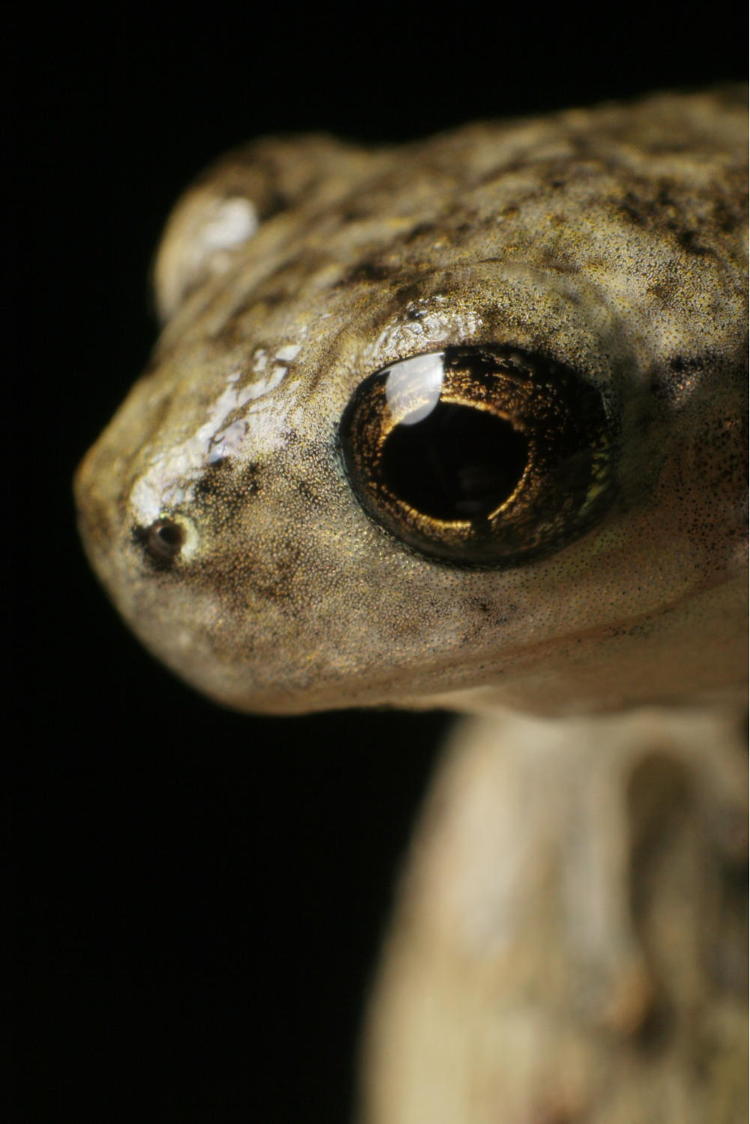
This is the exact same magnification as the cicada eye above, just so you know. And while you may question my judgment, I really like this shot – it will be a big print very shortly. Just for the specs, the entire frog is 12mm from snout to tailbone, and the eye itself measures 1.5mm across, slightly bigger than a pinhead. And I will admit that this is a stacked image, a combination of two separate frames, because the depth-of-field at f16 wasn’t even up to this. So there’s one image that has the eye sharp, and another that has the side of the face sharp; you can just make out the soft demarcation between the two images along the top right edge of the curve at the base of the eye. This’ll give you an idea how short focus really is (and thus, how precise my position would have to be to achieve it.)
Another scale shot? Okay, if you insist. Right before starting this post, I collected the abandoned exoskeleton (the cicada had long since moved on in search of some action, because that’s what adulthood is for,) and found another of the froglets sitting atop a rainbarrel. I doubt this is the same one as the portrait above and it might be marginally smaller, but close enough for government work, you know? Anything to give the best impression.

By the way, exactly a year ago I engaged in largely the same pursuit, with entirely different results.





















































Pretty damn cool sequence…